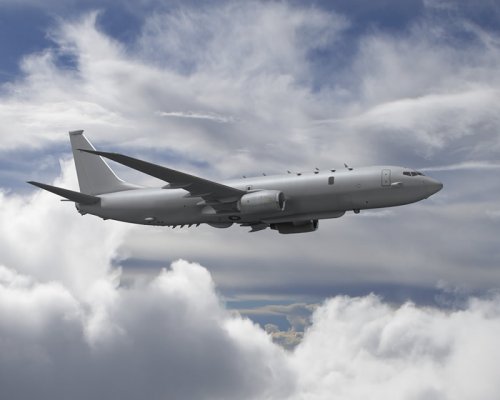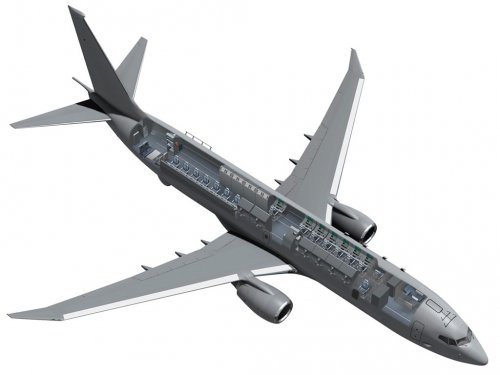The U.S. Navy has asked U.S. defense contractors to design and ultimately build a new signals intelligence (SigInt) platform to replace the service's aging fleet of Lockheed Martin EP-3E Aries II turboprops. Although the number of aircraft in the potential "EPX" order is relatively small by U.S. procurement standards — 14 to 24 is a popular estimate — the final selection could have a significant influence on how first-tier militaries conduct maritime surveillance for decades to come.
Not only will EPX be the newest Navy aircraft devoted to eavesdropping on enemy communications, it also will be the first to serve as the SigInt element of a networked ISR system incorporating manned and unmanned aircraft, satellites, ground stations and surface combatants. Detailed technical requirements are closely held, although the Naval Air Systems Command (NAVAIR) revealed the basic considerations to prospective bidders at a recent EPX industry day conducted at Naval Air Station Patuxent River, Md.
Kristine Wilcox, a NAVAIR spokeswoman, said EPX will be a manned ISR and targeting aircraft capable of operating in a SatCom-constrained environment, in concert with the P-8A Poseidon maritime patrol aircraft and the UAV ultimately selected for the Navy's Broad Area Maritime Surveillance (BAMS) bid. Wilcox said the competition is open to all interested parties and is expected to attract a diverse range of platform and sensor providers.
"Nothing is decided," she said. "We plan to work with industry to find the best solution."
This could be considered a minor revelation, as it opens the door to alternatives to what many had considered a fait accompli — a dedicated SigInt version of the twin-turbofan P-8A. Boeing unveiled this 737-based aircraft in January 2006, after the Navy dropped out of the Army-led Aerial Common Sensor (ACS) program. ACS was slated to replace the EP-3E and two types of Army reconnaissance aircraft, but the contract was canceled when ever-expanding mission requirements outgrew the winning platform, the Embraer 145 regional jet.
Given this background, Embraer seems an unlikely EPX bidder. But if the Brazilian manufacturer does attempt to scale the Pentagon's wall again, it now can offer the EMB-170/190 family — single-aisle airliners that appear able to carry any reasonable evolution of the EP-3E mission system. Embraer declined to comment on EPX, although senior executives previously conceded a post-ACS wariness of the U.S. acquisition process and specific issues with U.S. defense contractors serving as lead systems integrators.
Another airline narrowbody with potential EPX application is the EADS Airbus A320 family, and EADS representatives attended the Pax River briefing. NATO selected and then dropped a stretched derivative aircraft, the A321, as its platform for the Alliance Ground Surveillance program now in concept development.
General Dynamics' Gulfstream unit seems an obvious EPX contender, and its BAMS partnership with Boeing — built around an optionally-manned version of the G550 business jet — effectively positions both companies for EPX should the Navy call for a platform smaller than a 737. Gulfstream also could proceed without Boeing, but this seems unlikely unless BAMS is awarded to one of the other contenders.
Northrop Grumman is offering an AESA-equipped Block 20 Global Hawk UAV for BAMS, while Lockheed Martin has proposed a long-winged variant of the General Atomics Predator B UAV. The initial contract award was planned for October, but the decision was still pending as C4ISR Journal went to press.
Bombardier's Global Express — the chosen bus for the U.K.'s ASTOR battlefield radar program — is another potential EPX platform, but like Gulfstream, its fate is tied to the size and scope of the mission system. If the Navy keeps the size, weight and power demands within tight limits, observers believe, one of these converted corporate chariots could get the nod.
"Don't count the bizjets out," said Joe Siniscalchi, L-3 Communications Integrated Systems' director of business development. "Processing density has improved, allowing us to drive to smaller systems. With EPX, the biggest challenge is that you have the right size, weight and power to do what you need done. It's really a question of new development vs. reuse, and how much risk the customer is willing to take.
"EPX is very important to us. We're incumbent on the current platform and have been tracking developments for some time. We're very interested in seeing how the Navy program evolves. Clearly, the P-8A and BAMS programs will have an influence, but that being said, the Navy is in assessment mode. Certainly, the mission system will drive the requirements, and [P-8A] is built for an entirely different mission — anti-submarine warfare. With EPX, the big thing is how much onboard processing power will be needed to meet the required level of autonomy.
"On-scene, on-orbit, on-platform processing, tactical dissemination, linking back with the command authority — these are the kinds of things that will shape the EPX requirements. The Navy needs to be able to do what the EP-3E does, but it also has to plan for tomorrow's threats. Do you need 24 people, or will a data link suffice? This is the kind of question that has to be answered. More and more, software is driving capabilities, so it's much easier to build a smaller system that meets the mission but is easily upgraded as the requirements mature."
CONNECTING AN ISR TRIAD
Although the ability to process SigInt data in real time may have a strong influence on the final EPX systems configuration, forging robust electronic links with P-8A and BAMS could have equal weight in the hardware/software procurement arena. Although BAMS remains a wild card until contract award, Boeing hopes the apparent commonality between the P-8A and an "EP" version of the same aircraft will give it the edge, regardless of who wins the UAV contract.
"Our whole approach is to capitalize on the Navy's P-8A investment, as opposed to building from the ground up or refurbishing something to last for another 50 years," said Tim Norgart, business development director of Boeing's ASW/ISR unit, based in Puget Sound, Wash.
"When we first rolled out the [P-8A], there were two variants: Search & Attack and Surveillance & Intelligence. SI went away when the Navy went with the Army on ACS, but we felt confident that someone would eventually come back to an airplane of this size, for this mission. And now, with the Navy out of ACS and EPX a stand-alone program, they have. It's funny how things come full circle.
"Transitioning from the P-8A, we see very few changes to the airplane and can easily incorporate all the features needed for the SigInt mission. We do intend to leave the hard points on the wings intact, and the bottom forward section has all that strengthening for weapons, antennas and anything else the Navy wants to install. We'll also have a small ‘canoe' up there, but the structural work has already been done," Norgart said.
"P-8A has an open mission system architecture, and it's only a matter of plugging in the applications needed for the specific mission; you can ride the SigInt applications right on top of this backbone, without them cascading through the entire system. Of course, we'll also leverage the sensors that are already on the P-8A, like radar and [electro-optical/infrared], and the baseline [communications] links.
"The sharing and the workload capacity is there, and our ability to lay down a 14-operator configuration is very easy; you just bolt the work stations to the seat rails and hook up the power and cooling. With the P-8A, the wiring is already there for the power distribution, along with a significant reserve. We don't even make a dent in that figure.
"Our core development team worked together on the MRA4 Nimrod mission system, and we're going to leverage those work stations so the radar, ESM and all those kinds of things remain the same. We plan to stay with the Raytheon team that does the current system on the EP-3E; they're a big part of what we're doing and bring a tremendous amount of experience to this mission area.
"What we will be bringing on are a group of different SigInt providers, talking with all of them, to put a total system together. We're in our assessment phase now. If the Navy moves toward a [lead systems integrator] and wants to compete different parts of it, we'll do that.
"Onboard processing is still a great area for debate and could determine the size of the airplane required, but there are a whole lot of other things, as folks with the first ACS program will tell you. Our approach is really platform-agnostic. We didn't settle on the 737 by accident, or because of the P-8A.
"We take the total requirements picture and apply them to a wide range of air vehicles, and might end up with two vehicles to support the total set of requirements. We've known the requirements for EP-3E and EPX baseline, and they continue to drive our trade study to a 737-based approach.
"Programs that start out on the margins of payload and power capacity — the risk assigned is pretty high, and not many of them have been successful. When the margins are tight, if you want to put something on, you have to take something off," Norgart said.
MOVEMENT TOWARD MULTI-INT
Mission systems providers are conducting their own EPX trade studies on two parallel tracks. One assumes that the Navy will seek only to replicate EP-3E with a more modern platform, with machines replacing humans in some on-board roles. The second — and some say more likely — approach is that the service will regard the Aries II as merely a launching point, with EPX emerging as the first true multi-Int aircraft, and one with networking capability, as well.
"They definitely want to combine additional capabilities related to things on other aircraft; the key is to analyze the time line of the program," said Jim Courtright, director of maritime surveillance programs for Lockheed Martin.
"If you're looking 10 years forward, the technology will be packaged and integrated somewhat differently. The [EP-3E] systems are very federated for compartmentalization, and as a function of their design increments and block upgrade development.
"It's pretty clear that the Navy is going to need an open architecture for upgrades and new capabilities, with a system that fits with the overall system-of-systems architecture in 2015 or 2020. Also, they're going to want to take advantage of all the improvements in antennas, signal processing and other functions."
Raytheon, a major P-8A partner, sees EPX as a "positioning exercise." Jim Hvizd, the company's director of enterprise pursuits, said involvement could range from an upgraded search radar if the Navy goes plain vanilla, to a multilevel sensor suite incorporating SigInt, synthetic aperture radar, ground moving target indication, onboard processing, and UAV control/data collection, with or without help from ground stations.
"It's going to be interesting to see how the requirements flesh out, and we've heard everything from a business jet to a 737," Hvizd said. "The Navy still has to work out how EPX, P-8A and BAMS will work together. We're supporting Boeing on its BAMS bid, and our APS-137 [radar] could appear on the G550 BAMS; our radar for EPX would certainly draw from that legacy. Until the BAMS decision is made, I feel we're pretty constrained.
"Multi-Int on a single platform is a new thing, as is sharing data from multiple platforms, and we look at it as a way to serve the Navy's needs across all the maritime surveillance programs. What we've learned with [the United Kingdom's] ASTOR is how to deliver ISR capabilities unique to specific requirements, but from ASTOR to EPX will be a great leap forward. It comes down to a choice between another patrol plane or a flying battle station that can drastically shrink the sensor-to-shooter loop: That's what the Navy has to decide."



